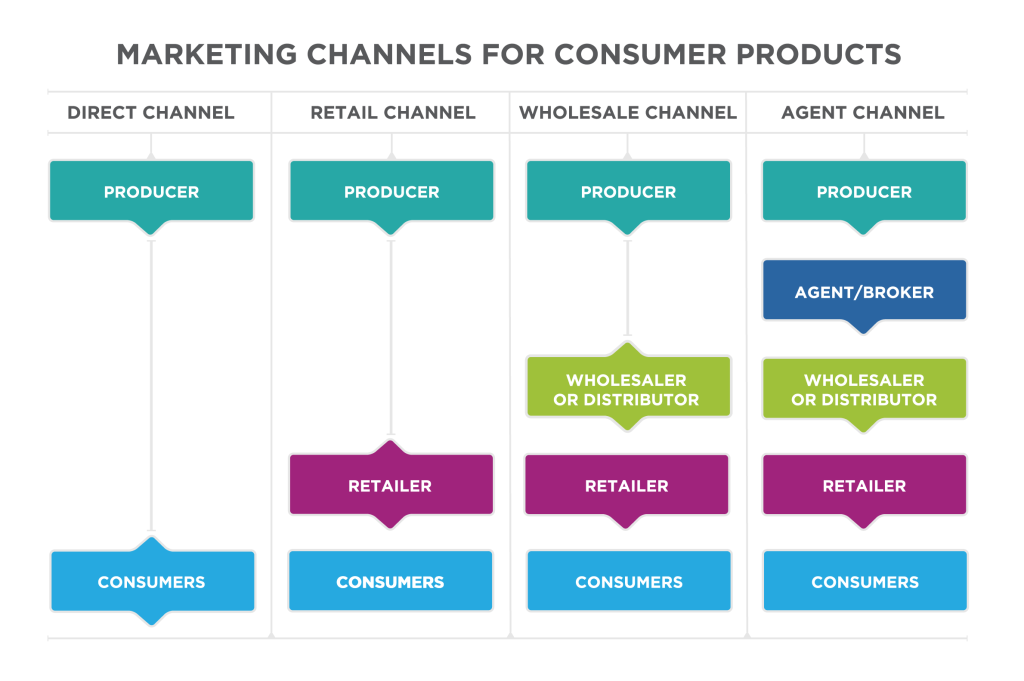9.2 Channel Partners
While channels can be very complex, there is a common set of channel structures that can be identified in most transactions. Each channel structure includes different organizations. Generally, the organizations that collectively support the distribution channel are referred to as channel partners.

Direct Channel
The direct channel is the simplest channel. In this case, the producer sells directly to the consumer. The most straightforward examples are producers who sell in small quantities. If you visit a farmer’s market, you can purchase goods directly from the farmer or craftsman. There are also examples of very large corporations who use the direct channel effectively, especially for B2B transactions. Services may also be sold through direct channels, and the same principle applies: an individual buys a service directly from the provider who delivers the service.
Examples of the direct channel include:
- Etsy.com online marketplace
- Farmer’s markets
- Oracle’s personal sales team that sells software systems to businesses
- A bake sale
Retail Channel
Retailers are companies in the channel that focuses on selling directly to consumers. You are likely to participate in the retail channel almost every day. The retail channel is different from the direct channel in that the retailer doesn’t produce the product. The retailer markets and sells the goods on behalf of the producer. For consumers, retailers provide tremendous contact efficiency by creating one location where many products can be purchased. Retailers may sell products in a store, online, in a kiosk, or on your doorstep. The emphasis is not the specific location but on selling directly to the consumer.
Examples of retailers include:
- Walmart discount stores
- Amazon online store
- Nordstrom department store
- Dairy Queen restaurant
Wholesale Channel
From a consumer’s perspective, the wholesale channel looks very similar to the retail channel, but it also involves a wholesaler. A wholesaler is primarily engaged in buying and usually storing and physically handling goods in large quantities, which are then resold (usually in smaller quantities) to retailers or to industrial or business users. The vast majority of goods produced in an advanced economy have wholesaling involved in their distribution. Wholesale channels also include manufacturers who operate sales offices to perform wholesale functions, and retailers who operate warehouses or otherwise engage in wholesale activities.
Examples of wholesalers include:
- Christmas-tree wholesalers who buy from growers and sell to retail outlets
- Restaurant food suppliers
- Clothing wholesalers who sell to retailers
Agent Channel
The broker or agent channel includes one additional intermediary. Agents and brokers are different from wholesalers in that they do not take title to the merchandise. In other words, they do not own the merchandise because they neither buy nor sell. Instead, brokers bring buyers and sellers together and negotiate the terms of the transaction: agents represent either the buyer or seller, usually on a permanent basis; brokers bring parties together on a temporary basis. Think about a real-estate agent. They do not buy your home and sell it to someone else; they market and arrange the sale of the home. Agents and brokers match up buyers and sellers, or add expertise to create a more efficient channel.
Examples of brokers include:
- An insurance broker, who sells insurance products from many companies to businesses and individuals
- A literary agent, who represents writers and their written works to publishers, theatrical producers, and film producers
- An export broker, who negotiates and manages transportation requirements, shipping, and customs clearance on behalf of a purchaser or producer
It’s important to note that the larger and more complex the flow of materials from the initial design through purchase, the more likely it is that multiple channel partners may be involved, because each channel partner will bring unique expertise that increases the efficiency of the process. If an intermediary is not adding value, they will likely be removed over time, because the cost of managing and coordinating with each intermediary is significant.
Introduction to Business (Lumen) The Marketing Mix 14.4: Place edited by LibreTexts, based on Introduction to Business by Boundless, is licensed under a Creative Commons Attribution-ShareAlike 4.0 International License.

